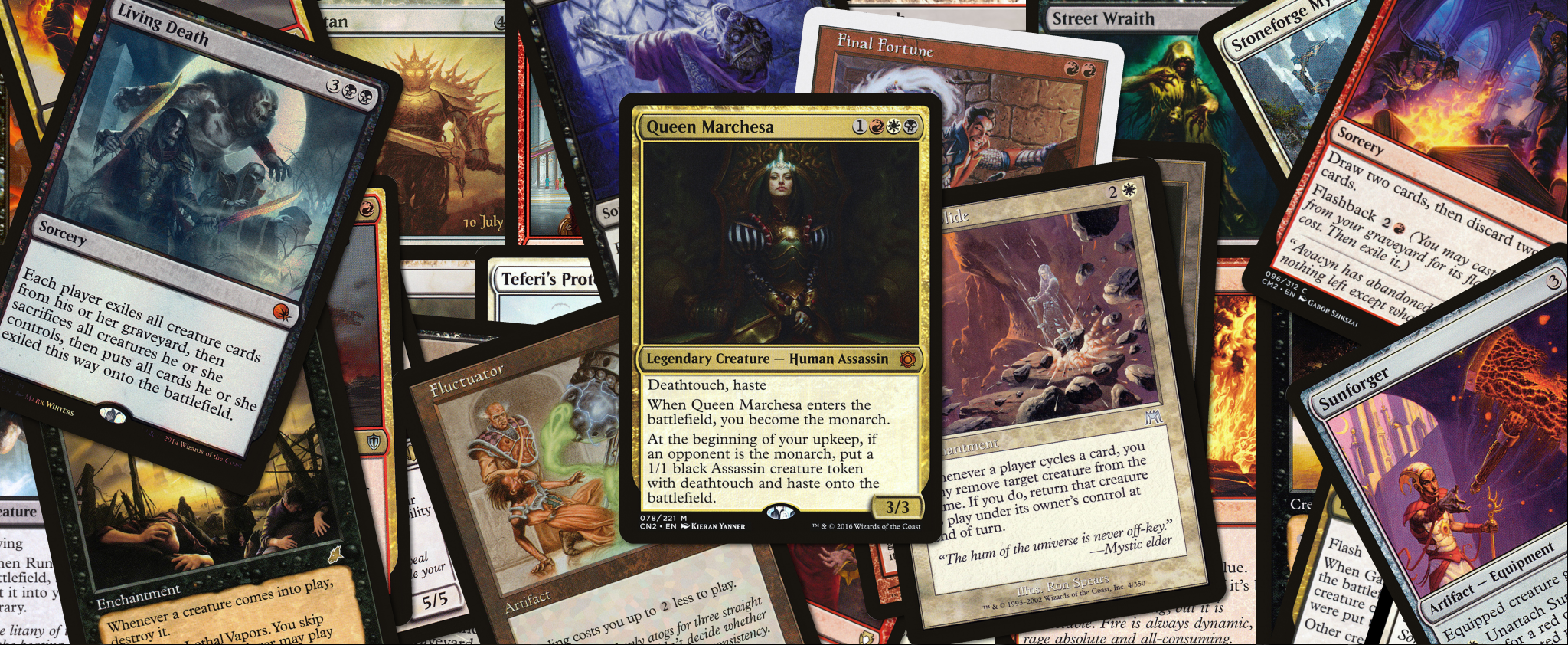Node.js Banner Generator
Customization is a large part of the culture surrounding EDH, a format of Magic the Gathering where players build a deck around a legendary creature. People spend thousands of dollars procuring special versions of cards for their deck, getting alterations painted on them, and getting them signed by the card’s artist. There’s a popular website for housing player’s decklists called Tapped Out. People here go hog-wild customizing their profile pages and deck lists, usually resulting in an experience reminiscient of Myspace circa 2005. One user, however, posted some cool images of scattered cards that he took with his camera and used them as banners on his deck page. I thought it was neat, well executed, and then forgot about it for several years.

What does this have to do with Node.js?
About a week ago I was looking for a small project to sharpen my dev skills when I re-stumbled on that user’s page and saw the banner images again. It clicked - here was an opportunity where I could make something tangible and get some good practice too. I decided to make a Node app that would generate banners for my deck pages. The big question here was: could it be done?
About two minutes into googling and I found my answer: Jimp, the Javascript Image Manipulation Program, a node module for doing image manipulation. I bookmarked it and went to bed.
Over the course of the next week I crafted up what is v1.0 of the EDH Banner Generator. It was a fantastic learning opportunity for me. I got a crash course in promises, had to do some deep dives on things like image compression, and even ran into a math problem that was over my head. Good thing I have a math wizard friend who wrote me up an equation; I’d have never figured this out on my own.
function postRotationScale(width,height,rotation) {
return Math.hypot(width,height)*(Math.sin(Math.atan(height/width)+Math.abs((rotation*(Math.PI/180)))));
}
Now that you know what this thing creates, here’s a deep dive of the process. The app consumes a list of cards from a text file the user provides to create an object of names. Users are able to specify a few things in their lists, like sets of cards with different printings and which card is their “commander”. Then, using Jimp, a blank canvas is created. For each card a request is made to Scryfall’s API to pull down an image and saved to the local filesystem. Subsequent requests for the same card will first look at this local store before attempt a GET on the API.
With an image consumed, it composites it onto the blank canvas following different rules; there are rotations and coordinate mapping that are randomized for a unique output each time. Once the compositing is done the final image is saved to the filesystem and ready to be used!
v1.0 is pretty barebones. It’s just the functionality, a readme, and some options via flags. The code is all piled into a single .js file. The cross-section of node.js developers and EDH fanatics is probably miniscule; a web-based deployment would open it up to people who want to use it. All of that said, I’m happy with it as a project and might consider expanding out and fixing these issues in future releases.
Archives
-
Inktober 2019 Highlights
Nov 1, 2019 -
Studying the Masters
Mar 17, 2019 -
Inktober 2018 Highlights
Nov 2, 2018 -
Node.js Banner Generator
Aug 5, 2018 -
Digital Painting #12
Jul 22, 2018 -
Digital Painting #11
Sep 26, 2017 -
EDH Draft League Web Site
May 1, 2017 -
Digital Painting #10
Mar 27, 2017 -
Digital Painting #9
Nov 6, 2016 -
Digital Painting #8
Jul 5, 2016 -
Digital Painting #7
Mar 21, 2016 -
Adventure.js
Feb 5, 2016 -
Digital Painting #6
Nov 27, 2015 -
Journey into Digital Painting
Nov 6, 2015 -
Website Re-launch
Nov 3, 2015